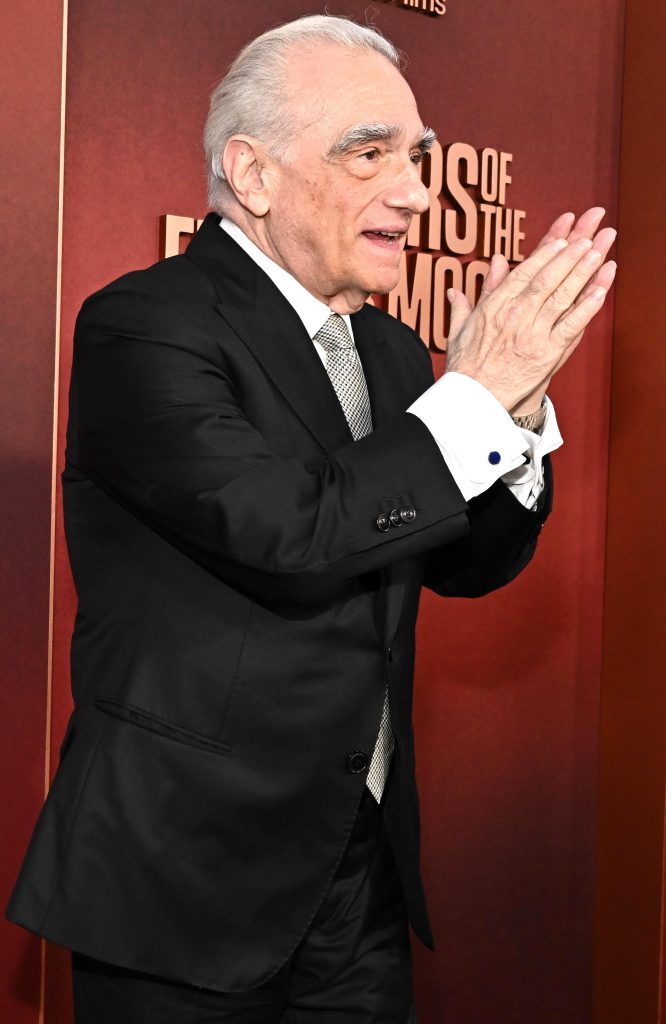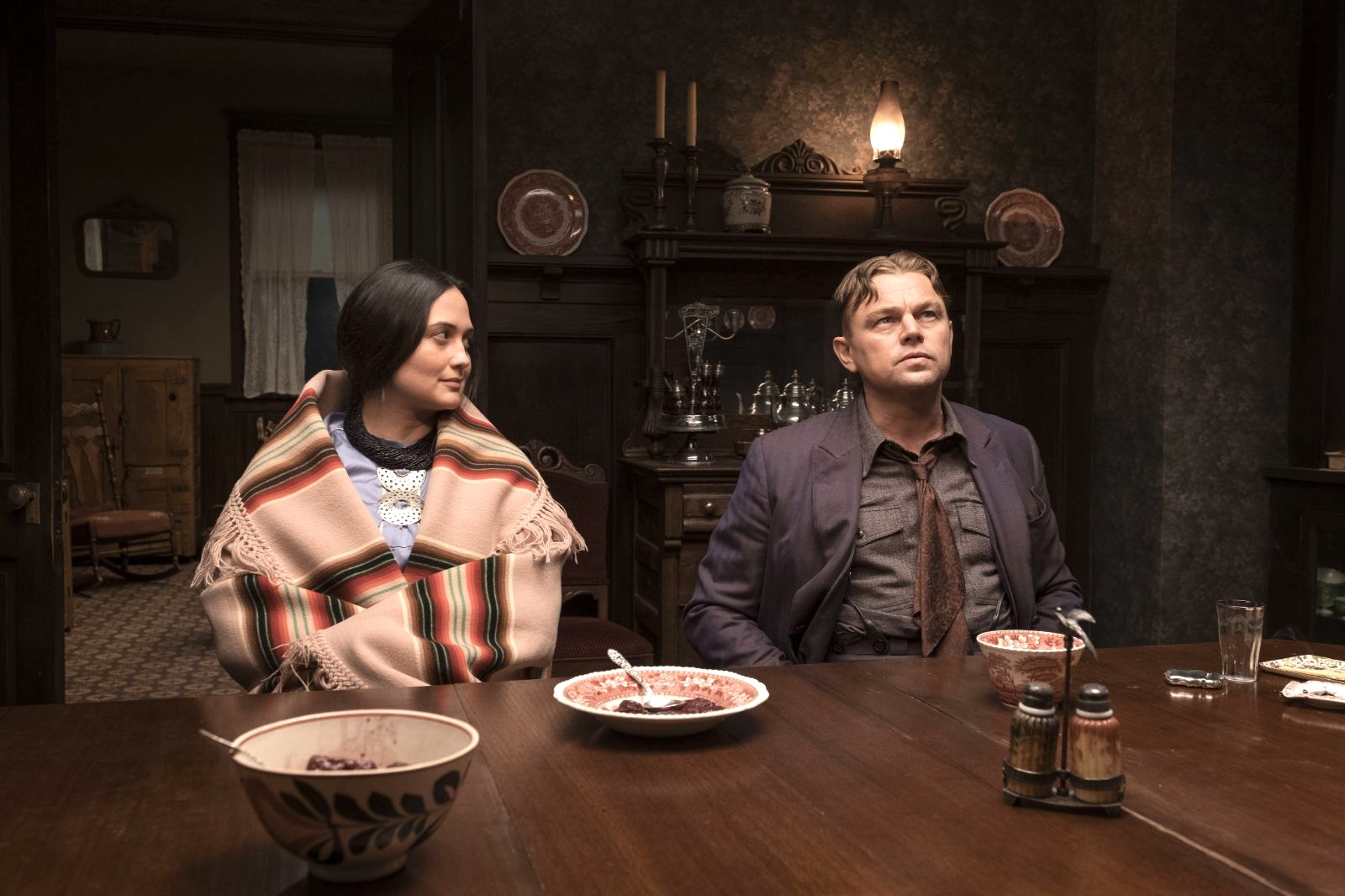The story of the Osage Nation and its people is a stain on America’s history and the casual, systemic genocide of indigenous people. Based on the novel, Killers of the Flower Moon: The Osage Murders and the Birth of the FBI by journalist David Grann, it shines a harsh spotlight on America’s history of crime and racism.
Killers tells the epic story of the Osage people becoming extremely rich from oil money (through mineral rights), the unlikely romance between Mollie Kyle (Lily Gladstone) and Ernest Burkhart (Leonardo Di Caprio) and Ernest’s ruthless betrayal of Mollie in pursuit of his second greatest love – money.
Although many Osagans became fantastically wealthy from oil money, their wealth was forcibly managed by the state-sanctioned guardian system where white people controlled the Osage finances and paid themselves handsomely for their services.
The murders weren’t conducted in a town square for public consumption. The people were slow-poisoned, shot in cold blood in the uncrowded prairies and recorded the cause of death as suicide. Many industrialists married into the Osage families as a way of legally claiming “headrights” to the oil wealth. It’s every bit as greedy and corrupt as you might imagine.
Acclaimed filmmaker, Martin Scorsese (Silence, Goodfellas), co-penned with Eric Roth (Dune, A Star is Born) brings this tragic story to our screens. Before depicting the brutal murders of the Osage Indians, Scorsese had to ensure the community was accurately and sensitively portrayed.

Martin Scorsese. Photo courtesy of Apple Original Films.
The filmmaker began to develop a fascination with Native Americans in the 70s when he visited South Dakota’s Pine Ridge Reservation. Years later, he became familiar with the tribes of the oil-producing Osage Nation in Oklahoma.
During his trekking through various reservations in the nation, Scorsese was irreversibly transformed by the spirituality of these tribes; specifically, their sacred concept of creation as a continuous cycle of birth, life, death. This was in sharp juxtaposition to white colonialism – extract all the oil until it runs out and move on to the next money-making venture.
Eric Roth and Martin Scorsese initially intended to tell the story through the perspective of Thomas Bruce White Sr., (Jesse Clemons) who solved the Osage murder cases. But the “ranger comes into town, asks probing questions until he solves the case” has been done before. We didn’t need another white savior story. The love story was the axis around which the film orbited.
The meticulous court transcripts of the time, which formed the basis of Grann’s book, helped Roth shape the story. Ernest Burkhart was complicit in killing Mollie’s sisters and slowly-killing her while simultaneously loving her, portrays the conflicted villain. The betrayal was the angle Scorsese chose to make Killers his own. The betrayal was the beating heart of the story.
The cultural collision was the canvas. His ultimate hope is to bring an awareness to the Osage Nation and offer some semblance of solace to the tribes through Western understanding.
Depicting The Osages From A Place Of Truth
“I’m fascinated by how you really deal with that culture in a way that is respectful, and also is hagiographic,” was Scorsese’s starting point.
Scorsese kneaded the story for authenticity, respect, dignity, sensitivity, openness, and honesty. “The cultural elements, rituals, and spiritual moments had to be real.” The mystical elements of the Osage culture weren’t embellished for cinematic enjoyment. The ancestors, the elders, the owls, the iconography, the chanting, were all real. The filmmaker wanted to contrast these components against the white European colonial world.
“We had a lot of support from the Osage authority from the experts who were giving us the indication about how to go about these things. And so, with them, we tested the accuracy of the rituals, the baby namings, the weddings, and the funerals.”
David Grann’s novel is extensively researched, so Martin Scorsese and his co-writer Eric Roth had ample source material. The Osage nation was becoming diffused as the oil interests displaced the native Indians. Roth and Scorsese visited Oklahoma on multiple occasion. Says Scorsese, “My first meeting was with Chief Standing Bear and his group, Julie and Addie Roanhorse, and Chad Renfro.” The pair were initially greeted with suspicion from them.
Another issue that Scorsese and Roth experienced was the relative lack of discussion about these horrific events which occurred in the 1920s. Many descendants and their families didn’t want to discuss it.
Moreover, White European Americans such as Bill Hale (Robert De Niro) were considered friends of the Burkhart family and the wider Osage community, so they didn’t believe Hale would do such things. Henry Roan (William Belleau) was Bill Hale’s best friend. Why would he kill him? “What is that about us as human beings that allows for us to be so compartmentalized?” Hale is the architect of the murders – a maddening mess of contradictions. Says Scorsese of Hale, “He’s like a prophet. He believes their time has come ‘I’ll help them. I’ll ease them into their graves. I’ll make it easier for them. Civilizations come and go.’”
One of Mollie Burkhardt’s ancestors questions the veracity of these historical accounts. “One has to remember that Ernest (Leonardo Di Caprio) loved Mollie, and Mollie loved Ernest. It’s a love story,” they claim.
“In some cases, there was wiggle room because I think the last two generations of Osagans forgot about the murders, or they were taken out of their experience because they had to become, White European.”
Initially Leonardo Di Caprio was set to play Tom White. When he was recast to play Ernest Burkhart, the dynamics of the script shifted. “We started reworking the script and it became gritty. Instead of coming from the outside in and finding out who did it, in reality, it’s who didn’t do it. It’s a story of complicity. It’s a story of sin by omission. Silent complicity,” continues Scorsese.
Flowers Of A Killer Moon was shot in Oklahoma. “When I got there, the prairies are quite something. They open your mind and your heart. They are just beautiful. And especially, driving on these straight roads, and on both sides, there are wild horses, and bison, and cows. It was idyllic. And then I began to realize that the land itself could be sinister. You’re a in a place like this and you don’t see people for miles.” You can do anything and nobody would know.
Much of Oklahoma looked the same as it did a hundred years ago. The law is discretionary and malleable. If you didn’t like it, you ignored it – with few repercussions.
“You can make the law work for you if you’re smart enough. What I wanted to capture, ultimately, was the very nature of the virus or the cancer that creates this sense of a kind of easygoing genocide. That’s why we went with the story of Mollie and Ernest because that’s the basis of the love. The love is the basis of trust,” explains Scorsese.
Casting Lily Gladstone as Mollie Burkhart
“I was very impressed by her presence; the intelligence and the emotion that’s in her face. You see it, you feel it. There’s something working behind the eyes. I loved her activism, which wasn’t overtaking the art,” recalls the filmmaker.
“The first big scene we did was one of my favorite scenes, where she has dinner with Ernest alone. She’s questioning him, ‘What are you doing here? What’s your religion?’ And then you begin to see the connection between the two. And when she says, “Ha ha ha, Coyote [Ernest] wants money,” and surprisingly, he replies,”That’s right. I love money.” Mollie is under no illusion of what motivates him.
Mollie’ sisters said, ‘That guy with the blue eyes likes you,’ and, ‘Well, I don’t think he just wants money. It doesn’t matter. He’s nice. He wants to settle down.'” These moments were thumb tacks in the script to highlight their love.
In another scene, Ernest is driving Mollie in his taxi and she says something in Osage. “He says, ‘What did you say?’ and she says it in Osage again. And he says, “Well, I don’t know what that was, but it must have been Indian for handsome devil.’ And that’s an improv, and you see her laugh for real,” adds the filmmaker.
On Working With Robert De Niro and Leonardo Di Caprio
Martin Scorsese has worked with De Niro for over fifty years and Di Caprio for over twenty. “In the case of Robert De Niro, we were teenagers together, and he’s the only one who really knows where I come from and the people I knew. Some of them are still alive. I know his friends. We had a real testing ground in the ’70s, where we tried everything and we found that we trusted each other.” This is important to Martin Scorsese because sometimes an actor can have too much power and derail your film.
“With Robert, I never felt that. There was a freedom, there was experimenting, and also not being afraid of anything. Years later, he told me he worked with this kid, Leo DiCaprio, a little boy, in This Boy’s Life, and he said, “You should work with this kid sometime.” Robert De Niro doesn’t make recommendations unless he truly believes them.

Ernest Burkhart (Leonardo Di Caprio) & Bill Hale (Robert De Nito) Photo courtesy of Apple Original Films
Leonardo Di Caprio worked on The Gangs Of New York, Aviator, and The Departed. “He loved the pictures I’ve made, and he wanted to explore the same territory. And so we developed more of a relationship. There was a maturity in him.”
Scorsese recalls Di Caprio calling him one time to discuss the Yasujiro Ozu style of filming in Tokyo Story. “That’s very interesting to me, to be open that way to older parts of our culture, newer parts of our culture. And the curiosity that he has about other people and other cultures.” The pair push each other to do great work.
The filmmaker observes the dynamics between Di Caprio and De Niro in Killers Of The Flower Moon. Scorses cites the scene at the end when they’re both in jail and Ernest chooses to testify against his uncle Bill. “That scene was finally written a few days before we shot it, working with the two of them, because we had said so much and it could have gone so many different ways. But what does the picture really need? How much more is there for them to say to each other after all that’s happened?”
The Music Of Killers Of The Flower Moon
“The way I like to make pictures for the most part is by the pacing of music. I’m trying to get to the pacing and rhythm of something that can be played. I felt it. I couldn’t verbalize the way I am now, but I felt it in the shoot and in the edit. A lot of the music that kept pushing me was what composer Robbie Robertson had put together, particularly that bass note that he was playing when when Ernest drops Mollie off for the first time at her house. She looks at him, she turns, and all of a sudden you hear boom, boom, boom, boom, boom, boom. I said I wanted something dangerous and fleshy. And sexy, but dangerous. And that beat took us all the way through.”
“Then Robbie sent me some hymns and I could pick the music from Harry Smith’s anthology of folk music. One particular piece called ‘Indian War Whoop’ by Hoyt Ming & His Pep Steppers was very important.”
“Bulldoze Blues by Henry Thomas, which became Going Up The Country by Canned Heat, Dark As The Night, and Blind Willie Johnson, See See Rider by Ma Rainey, Emmett Miller singing Lovesick Blues were vital. All that’s in there, but the drive of the movie is what Robbie put down.“
